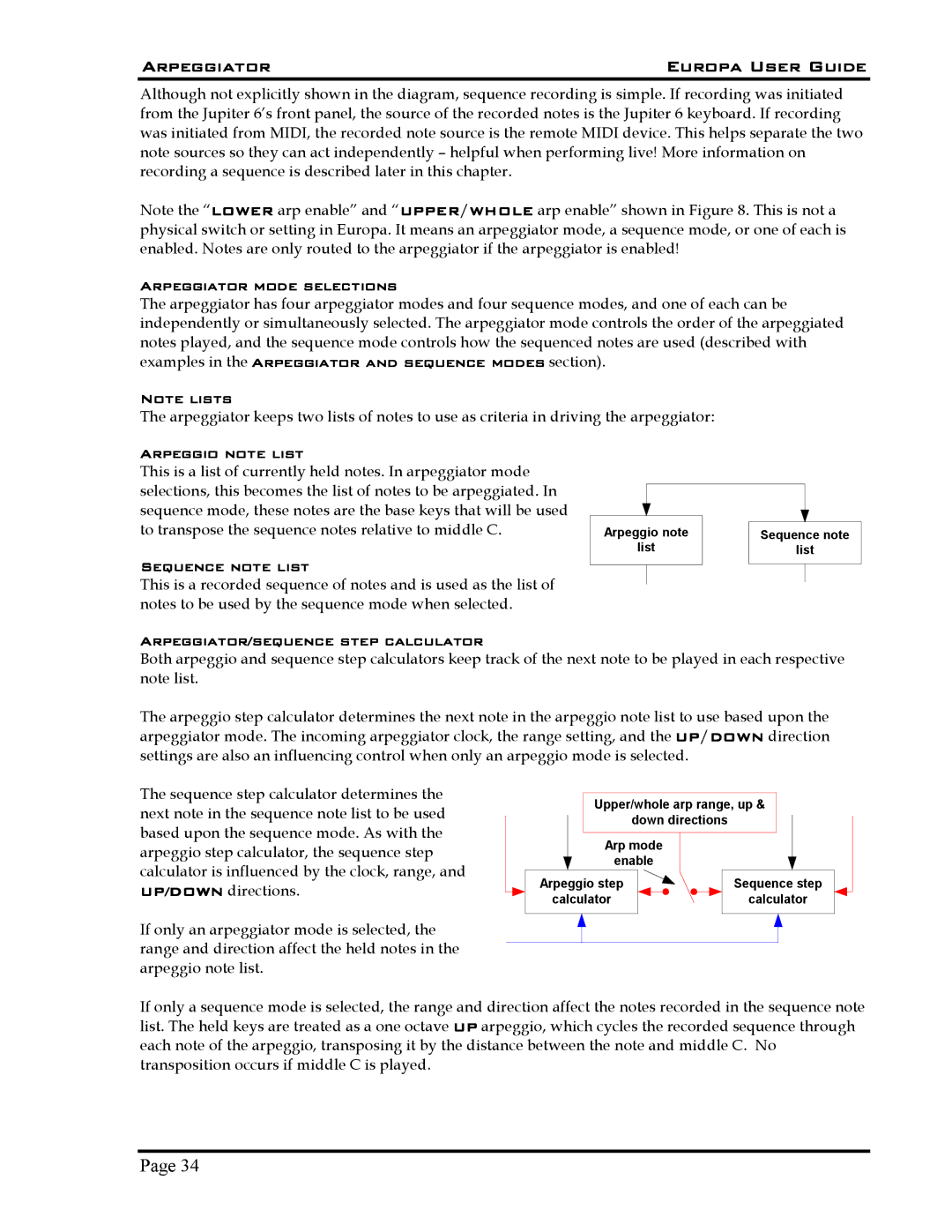
Arpeggiator | Europa User Guide |
Although not explicitly shown in the diagram, sequence recording is simple. If recording was initiated from the Jupiter 6’s front panel, the source of the recorded notes is the Jupiter 6 keyboard. If recording was initiated from MIDI, the recorded note source is the remote MIDI device. This helps separate the two note sources so they can act independently – helpful when performing live! More information on recording a sequence is described later in this chapter.
Note the “LOWER arp enable” and “UPPER/WHOLE arp enable” shown in Figure 8. This is not a physical switch or setting in Europa. It means an arpeggiator mode, a sequence mode, or one of each is enabled. Notes are only routed to the arpeggiator if the arpeggiator is enabled!
Arpeggiator mode selections
The arpeggiator has four arpeggiator modes and four sequence modes, and one of each can be independently or simultaneously selected. The arpeggiator mode controls the order of the arpeggiated notes played, and the sequence mode controls how the sequenced notes are used (described with examples in the Arpeggiator and sequence modes section).
Note lists
The arpeggiator keeps two lists of notes to use as criteria in driving the arpeggiator:
Arpeggio note list
This is a list of currently held notes. In arpeggiator mode selections, this becomes the list of notes to be arpeggiated. In sequence mode, these notes are the base keys that will be used to transpose the sequence notes relative to middle C.
Sequence note list
This is a recorded sequence of notes and is used as the list of notes to be used by the sequence mode when selected.
Arpeggio note
list
Sequence note
list
Arpeggiator/sequence step calculator
Both arpeggio and sequence step calculators keep track of the next note to be played in each respective note list.
The arpeggio step calculator determines the next note in the arpeggio note list to use based upon the arpeggiator mode. The incoming arpeggiator clock, the range setting, and the UP/DOWN direction settings are also an influencing control when only an arpeggio mode is selected.
The sequence step calculator determines the next note in the sequence note list to be used based upon the sequence mode. As with the arpeggio step calculator, the sequence step calculator is influenced by the clock, range, and UP/DOWN directions.
If only an arpeggiator mode is selected, the range and direction affect the held notes in the arpeggio note list.
Upper/whole arp range, up &
down directions
Arp mode
enable
| Arpeggio step |
|
|
|
|
| Sequence step | ||
| calculator |
|
|
|
|
| calculator | ||
|
|
|
|
|
|
|
|
|
|
|
|
|
|
|
|
|
|
|
|
|
|
|
|
|
|
|
|
|
|
If only a sequence mode is selected, the range and direction affect the notes recorded in the sequence note list. The held keys are treated as a one octave UP arpeggio, which cycles the recorded sequence through each note of the arpeggio, transposing it by the distance between the note and middle C. No transposition occurs if middle C is played.
Page 34
